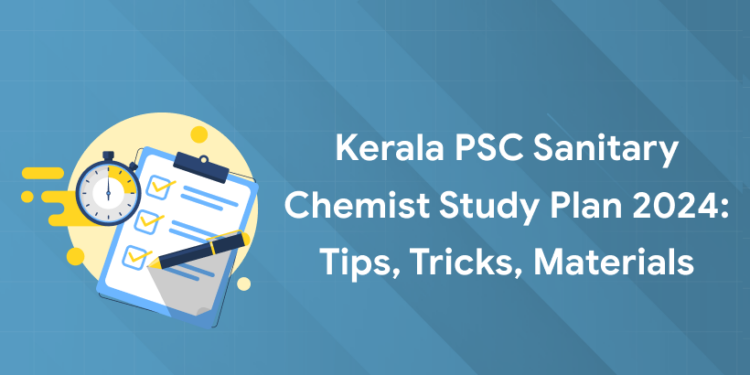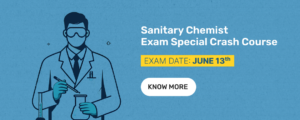Table of Contents
Kerala Public Service Commission will be recruiting eligible candidates for the post of Sanitary Chemist posts under the Kerala Water Authority ,Category number 127/2023 aim to fill the 04 vacant posts. An official notification regarding this was released by the Commission on July 17,2023. Eligible candidates will be selected through Written exams along with Interviews. The Post is open under the age of 36. Visit the official page of Kerala Public Service Commission (KPSC) for more details.
As the recruitment notifications are released, all candidates have to take their preparations seriously and follow a strict study method for high scores in the exam. The Sanitary Chemist preparation is done best when you make a topic-intensive study plan. There will be a tough competition as the number of vacancies are less. So, select effective study materials for the preparation. Before the preparation starts, the candidates must be on hold of sufficient study materials and must have an idea about the best study materials that are available.
Kerala PSC Sanitary Chemist Study Plan 2024
As the date of exam notifications are released, all candidates have to take their preparations seriously and follow a strict study method for high scores in the exam. There will be a tough competition as the number of vacancies are less. So, select effective study materials for the preparation.
Planning out a timetable for your preparations is the first step to scoring high marks. Put your own effort into creating one or else you can follow the below-given study plans. It all depends on you. Try not to pressurize yourself. Take short notes as you go through the topics. Understand which are the topic that carries maximum marks weightage and divide your study schedule accordingly.
Day Wise Table- Study Plan of 30 Days
| Days | Topics |
| Day 1 |
|
| Day 2 |
|
| Day 3 |
|
| Day 4 |
|
| Day 5 |
|
| Day 6 |
|
| Day 7 |
|
| Day 8 |
|
| Day 9 |
|
| Day 10 |
|
| Day 11 |
|
| Day 12 |
|
| Day 13 |
|
| Day 14 |
|
| Day15 |
|
| Day 16 |
|
| Day 17 |
|
| Day 18 |
|
| Day 19 |
|
| Day 20 |
|
| Day 21 |
|
| Day 22 |
|
| Day 23 |
|
| Day 24 |
|
| Day 25 |
|
| Day 26 |
|
| Day 27 |
|
| Day 28 |
|
| Day 29 |
|
| Day 30 |
|
Kerala PSC Sanitary Chemist Previous Questions
Candidates can download sanitary chemist previous questions below!
Tips for Effective Preparation for the Kerala PSC Sanitary Chemist Exam
Preparing for the Kerala PSC Sanitary Chemist Exam requires a structured approach and a thorough understanding of the subjects covered. Here are some tips to help you streamline your preparation and maximize your chances of success:
Understand the Exam Pattern and Syllabus: Familiarize yourself with the exam pattern, marking scheme, and syllabus prescribed by the Kerala Public Service Commission. Understanding the weightage of each topic will help you allocate your time and resources effectively.
Create a Study Plan: Develop a comprehensive study plan that covers all the subjects and topics included in the syllabus. Break down your study schedule into manageable sections, allotting sufficient time for each subject.
Refer to Standard Textbooks: Utilize standard textbooks recommended for topics such as Chemistry, Microbiology, Environmental Science, and Sanitary Engineering. Make sure to choose books that cover the entire syllabus in detail and are written by renowned authors.
Practice Previous Year Question Papers: Solve previous year question papers to familiarize yourself with the exam pattern, types of questions asked, and time management. Analyze your performance and identify areas where you need improvement.
Take Mock Tests: Regularly take mock tests and practice quizzes to assess your preparation level and identify weak areas. Mock tests simulate the exam environment and help improve your speed and accuracy in solving problems.
KERALA PSC SANITARY CHEMIST FREE MOCK TEST SERIES 2024
Focus on Conceptual Understanding: Instead of rote memorization, focus on understanding the underlying concepts and principles. This will not only help you answer questions more accurately but also enhance your problem-solving skills.
Revise Regularly: Schedule regular revision sessions to reinforce your learning and ensure better retention of information. Create concise notes or flashcards summarizing key concepts for quick revision.
Stay Updated with Current Affairs: Keep yourself updated with current affairs, especially topics related to sanitation, environmental conservation, public health policies, and scientific advancements. This will help you answer questions related to the application of knowledge in real-world scenarios.
Seek Clarification: If you encounter any doubts or difficulties while studying, don’t hesitate to seek clarification from teachers, mentors, or online forums. Clarifying doubts promptly will prevent misconceptions from persisting.
Main Topics to Cover : KPSC Sanitary Chemist 2024
The syllabus Plays key role in the preparation as well as acquiring effective study materials. In a syllabus, there can be topics that are very important because the questions from those topics appear frequently in the exams. Therefore, it is necessary to refer to the previous year’s questions to find the main topics. The main topics that the candidates should not miss under any circumstance are given below.
Kerala PSC Sanitary Chemist Sample Questions and Answers
Q.1 The emissions of an α particle and two β particles in succession produce an ………………of the starting atom.
(a) Isotope (b) Isobar (c) Isotone (d) Isomer
Ans: (a) Isotope
Q.2 The order of the C₂V point group is:
(a) 3 (b) 4 (c) 1 (d) 2
Ans: (b) 4
Q.3 Among CO, NO, HCl and CO₂, that which will not yield a microwave spectrum is:
(a) CO (b) NO (c) HCl (d) CO₂
Ans: (d) CO₂
Q.4 The number of the normal mode of vibration of C6H6 molecule is (a) 30 (b) 36 (c) 31 (d) 35
Ans: (a) 30
Q.5 The π donor ligand in Ziese’s salt is
(a) Chlorine (b) Ethylene (c) Acetylene (d) Carbonyl
Ans: (b) Ethylene
Q.6 The number of signals exhibited by the protons of TMS in its NMR Spectrum is:
(a) 2 (b) 1 (c) 3 (d) 4
Ans: (b) 1
Q.7 Which among the following is the optical property of colloid?
(a) Brownian Movement (b) Electrophoresis (c) Tyndal Effect (d) Electro Osmosis
Ans: (b) Electrophoresis
Q.8 How many isoprene units are present in monoterpenes?
(a) 3 (b) 4 (c) 2 (d) 1
Ans: (c) 2
Q.9 Radioactive disintegration follows …………… order kinetics.
(a) First Order (b) Second Order (c) Third Order (d) Fourth Order
Ans: (a) First Order
Q.10 The emission of radiant energy after a time lag after its absorption by a substance is called:
(a) Fluorescence (b) Phosphorescence (c) Vibrational Relaxation (d) Inter System Crossing
Ans: (b) Phosphorescence
Grab Study Materials for Kerala PSC Exams !!! Register Now !
| Kerala PSC Sanitary Chemist Exam Information Links | |
| Kerala PSC Sanitary Chemist Assistant Notification | Kerala PSC Sanitary Chemist Mock Test |
| Kerala PSC Sanitary Chemist Syllabus | Kerala PSC Sanitary Chemist Video Course |
| Kerala PSC Sanitary Chemist Exam Date | Kerala PSC Sanitary Chemist Study Materials |
| Kerala PSC Sanitary Chemist Application Form | Kerala PSC Sanitary Chemist Interview Questions |
| Kerala PSC Sanitary Chemist Vacancy | Kerala PSC Sanitary Chemist Job Profile |
| Kerala PSC Sanitary Chemist Admit Card | Kerala PSC Sanitary Chemist Salary |
| Kerala PSC Sanitary Chemist Preparation Tips and Tricks | Kerala PSC Sanitary Chemist Study Plan |
| Kerala PSC Sanitary Chemist Best Books | Kerala PSC Sanitary Chemist Result |
| Kerala PSC Sanitary Chemist Eligibility Criteria | Kerala PSC Sanitary Chemist Cutoff |
| Kerala PSC Sanitary Chemist Selection Process | Kerala PSC Sanitary Chemist Exam Analysis |
| Kerala PSC Sanitary Chemist Question Paper | Kerala PSC Sanitary Chemist Answer Key |












